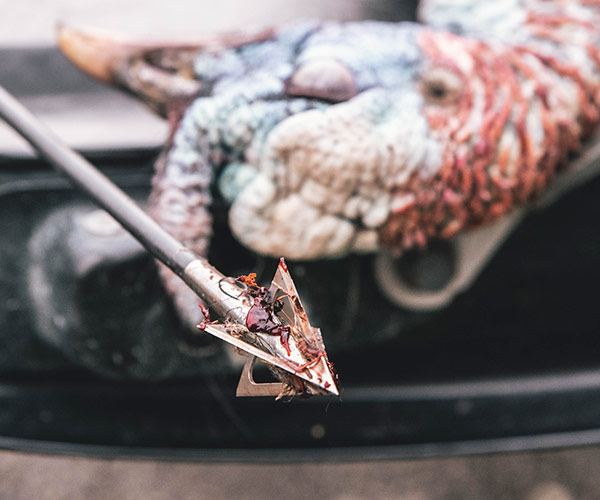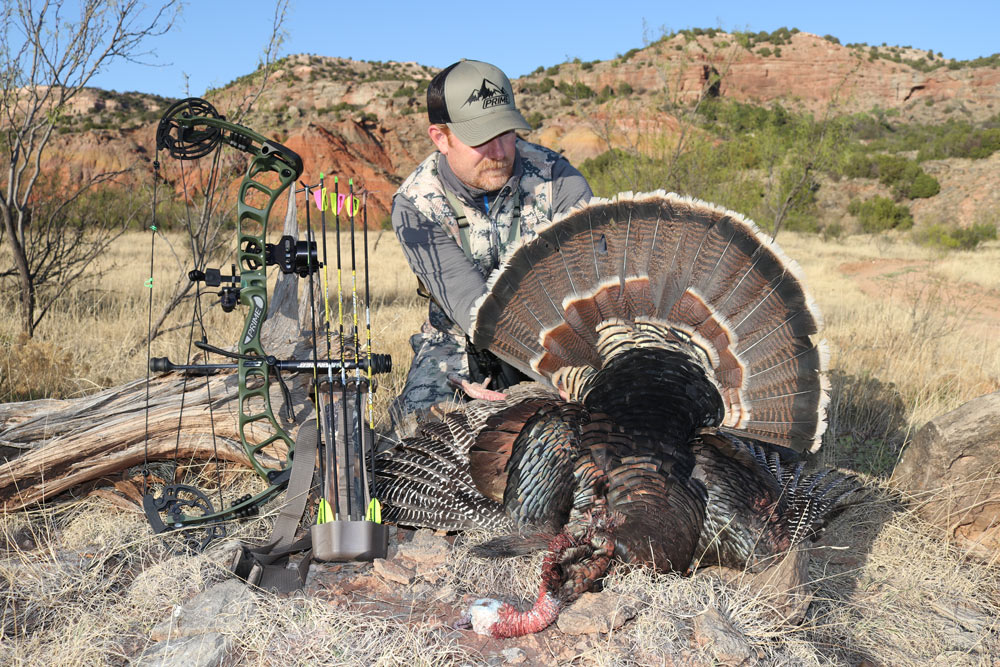
Choosing the right Turkey Hunting setup
Spring turkey is next on the bowhunter’s calendar and everyone is asking what the best Turkey Hunting broadhead and bow setup is. In my mind, this unique hunt calls for a very different and very specific bow rig. Here are a few of the details I prefer in my turkey set up.
For most, this game is played from a ground blind. I typically shoot from my knees or off a short chair inside the blind. A short axle bow is ideal for such a scenario. Something in the 28-32-inch range, like the Prime Nexus 32, is ideal and very maneuverable. Next, it must be smooth and whisper quiet. Look for mild cams that roll over without “jerking” to full draw. For Turkey Hunting, I prefer a bow with 80-85 % let-off so once the bow is back, I can hold it waiting for the bird to give me the right shot angle. Place soft camo moleskin around the arrow rest and bow riser to prevent any noise if the arrow bumps the bow.
Turkey Hunting Tips
A huge gobbler only weighs 20-25 pounds. You don’t need lots of draw weight to kill even a giant turkey. My turkey rig’s draw weight is usually set between 55-60 pounds. A modest draw weight helps with drawing very smooth without unnecessary movement and also holding the bow solid, waiting for the shot. My Turkey Hunting rig will include a short stabilizer and a simple, single pin sight. Consider a light on the bow sight since it will be dark inside the blind. I keep shots close on turkeys, usually under 20 yards. I prefer a quality, fixed 4-blade broadhead, like the G5 Striker X, for a shot to the body, and also a head-lopper style broadhead for head/neck shots. Head-lopper style broadheads can be very tricky because it can be difficult to get them to fly straight. I’ve found the smaller, 100 grain versions fly better than the larger 125 grain models. A slightly stiffer arrow shaft than what is called for on the charts and larger or more helical fletching helps steer these unique broadheads.
Other things to consider when Turkey Hunting
There’s more to consider. Close all the windows of the pop-up blind except the primary shooting hole to keep things as dark as possible. I even hang a black shirt over part of the only window open, giving myself enough room for a clear shot, but nothing extra.
Turkeys have X-ray vision, so don’t give them a gap to spot you move! Set several decoys at close range. My go-to set up is a spread of four decoys about 8-10 yards from the blind. The spread includes a bedded hen with a half-strut jake over it and two other hens. Most of the time, a mature gobbler will go to the jake to knock him off the hen, so set the jake where you want the shot to happen. Take it a step further and wear black clothes inside the blind and shoot a black bow. This is serious stuff, man against bird, so go all out! For success this spring, match your rig to the gig. Choose a short axle bow with a modest draw weight. Keep the accessories simple and the sight system simple. Keep shots close and Mr. Tom will be wearing your tag.
Keep It Simple
For success this spring, match your rig to the gig. Choose a short axle bow but with a modest draw weight. Keep the accessories simple and the sight system simple. Keep shots close and Mr. Tom will be wearing your tag.

The fluffed-up gobbler was a scant 15 steps from my blind. Hidden in the shadows at the back of the blind, I slowly eased my bow to full draw. The Texas gobbler’s ninja-like senses kicked in and he let out of his strut, now on full alert. Suspicious, he started to slowly walk away. My bright green sight pin steadied and the arrow was gone, lopping the big tom in the neck. He flopped like a fish out of water. The big Texas Rio Grande had sharp spurs, a pretty tail fan and a thick beard. It was a good day.
Written By Brandon Ray
Follow Brandon on Instagram @brandonrayoutdoors
